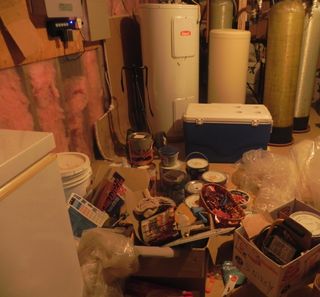Environment
Assessing Risks and Priorities in a Hoarded Environment
Taking a closer look at clutter.
Posted December 2, 2019
An excellent tool Elaine uses with clients is the Clutter Checklist below. This assessment tool helps to highlight the specific areas in your home that require a priority status for remediation.
Note: This checklist is not a report card. There is no need to score yourself. This checklist is meant to provide information to help you develop a risk-averse plan to move forward.
You can also use it to track your progress as you move forward.
A reproducible version of this checklist is available online should you need a more usable copy.
Clutter Checklist
Answer Yes or No to Each Question Below.
*Your local fire code regulations must be followed, but you may find that 33-36 inches clear around heat sources such as furnaces, hot water tanks, and electrical panels are code-approved in your area. A clear path should be available to a minimum of two entrances/exit routes. Boxes with 2 stars are top priorities to resolve.
** Boxes represent serious potential fire hazards. Boxes with 1 star represent the next top priority to resolve.
Entryway
1. Do the doors open all the way?
2. Is there an accumulation stored behind the door?
3. Is there a clear passage to other rooms? If no, the risk is *
4. Is a smoke detector in place and working? If no, the risk is **
Kitchen
5. Is there a clear passage to other rooms? If no, the risk is *
6. Are items prone to falling out of cupboards?
7. Are countertops covered with items?
8. Are items stored on top of the stove? If yes, the risk is **
9. Are items stored in front of the stove?
10. Is there permanent use of extension cords? If yes, the risk is **
11. Is there clear ventilation around the refrigerator?
12. Are spaces usable for their intended purpose?
Living Room
13. Is there a clear passage to other rooms? If no, the risk is *
14. Is there a clear passage to the rear exit/entry, if applicable? If no, the risk is *
15. Are spaces usable for their intended purpose?
16. Is there permanent use of extension cords? If yes, the risk is **
17. Are items stored on top of heat vents? If yes, the risk is **
Bedrooms
18. Are items hanging from the door?
19. Do doors open all the way?
20. Are items stored behind the door?
21. Are items stored on top of heat vents? If yes, the risk is **
22. Are spaces usable for their intended purpose?
23. Is there clear access to the closet?
24. Is there permanent use of extension cords? If yes, the risk is **
Bathrooms
25. Are items hanging from the door?
26. Does the bathroom door open all the way?
27. Are items stored behind the door?
28. Are spaces usable for their intended purpose?
29. Are items stored in the bathtub or shower?

Basement or Storage Space
30. Is there clear access to the electrical panel/hot water tank/furnace? If no, the risk is *
31. Are items prone to falling (tipping, falling off shelves, etc.)?
Garage
32. Is there a clear sight of the floor?
33. Are items stored in the garage that are not related to outdoor use?
34. Is there permanent use of extension cords? If yes, the risk is **
35. Is there clear access to garage doors? If no, the risk is *
36. Are spaces usable for their intended purpose?
Balcony/Patio
37. Is there a clear sight of the floor?
38. Are items stored on the balcony/patio that are not related to outdoor use?
39. Is there permanent use of extension cords? If yes, the risk is **
40. Is there clear access to an entrance door? If no, the risk is *
Environmental Risk
Once you complete this assessment, ask yourself: What risk does your clutter represent for you (and those living with you, including pets), others who may be affected, such as neighbors, and any others who need to access your home, such as emergency responders?
1. Obstructed entrances and/or exits, increase your risk. Two clear (entirely unobstructed) ways to enter or exit your residence are essential in case of emergency.
2. Is there clear access to every room?
3. Is there an accumulation near ignition sources, such as:
- Furnaces
- Stoves
- Space, baseboard, portable, and water heaters or any other heat source
- Uncovered light bulbs
- Other combustible items (things that conduct heat or burn)
- Electrical panel (circuit breaker or fuse boxes). If wiring is old, check the amperage of all fuses regularly and take blown fuses seriously.
4. If extension cords are being used semi-permanently or permanently, this almost certainly contravenes local fire codes.

- Rooms should be reorganized so that all electrical devices can be plugged directly into wall outlets.
- Extension cords cannot be used in place of an adequate number of permanently-wired electrical outlets connected to the electrical panel. All electrical work should be done by a qualified electrician.
- Extension cords are a serious tripping hazard and are vulnerable to vermin chewing through them and starting fires.
Absolute Must’s:
- Smoke detectors (number and placement must meet your local fire standards)
- Carbon monoxide detectors, where legislated
- Blocked or obstructed stairs must be cleared, including top, bottom, and midway landings, to prevent tripping, losing one’s balance, and falling.
This post has discussed how hoarding affects your safety. In our next post, we will discuss how hoarding affects your activities of daily living and quality of life.




